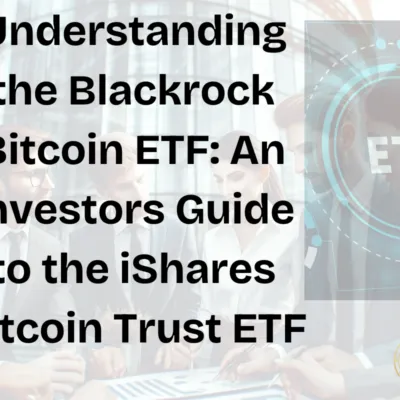What does the $127 million BlackRock Bitcoin Investment mean for the future of crypto investment?
Bitcoin, once dismissed as a speculative playground for tech enthusiasts and libertarians, has steadily marched into the mainstream financial world. The latest milestone in this journey is BlackRock’s $127 million investment in Bitcoin through its iShares Bitcoin Trust (IBIT), a move that has sent ripples through both crypto and traditional markets. With the world’s largest asset manager now holding over 559,000 BTC, valued at roughly $58.51 billion as of early 2025—and other institutions like Barclays, Wisconsin’s investment board, and even sovereign wealth funds jumping on the bandwagon, a pressing question emerges: Can this growing institutional adoption transform Bitcoin into a more stable and solid investment? In my view, while institutional involvement lends credibility and potential stability, Bitcoin’s inherent volatility and unique market dynamics mean it’s not quite ready to shed its wild reputation entirely—though it’s certainly on a promising trajectory.
Let’s start with the bullish case. BlackRock Bitcoin Investment isn’t just a footnote; it’s a seismic shift. With over $10 trillion in assets under management, BlackRock wields unparalleled influence in global finance. When its CEO, Larry Fink, predicts Bitcoin could hit $700,000 amid fears of currency debasement and economic instability, people listen. Fink’s evolution from a crypto skeptic to an advocate underscores a broader narrative: Bitcoin is no longer a fringe asset. His comments at the World Economic Forum in Davos, suggesting that widespread adoption could push BTC’s price to half a million or more, reflect a growing consensus among financial elites that Bitcoin offers a hedge against faltering fiat systems. This isn’t just talk—BlackRock’s IBIT has captured over 50% of the U.S. Bitcoin ETF market share, with inflows exceeding $60 billion since its 2024 launch. Add to that the $125 billion milestone for spot Bitcoin ETFs collectively, and you have a clear signal: institutional money is pouring in at an unprecedented rate.
This influx matters because institutions bring structure to a historically chaotic market. Unlike retail investors, who often buy and sell on emotion—driving Bitcoin’s infamous price swings—firms like BlackRock operate with long-term strategies, deep pockets, and regulatory oversight. Their participation can dampen volatility by increasing liquidity and smoothing out speculative spikes. Take Nasdaq’s recent proposal for in-kind redemptions on BlackRock’s ETF, allowing institutional investors to swap shares directly for Bitcoin. This innovation reduces sell pressure on BTC during redemptions, potentially stabilizing its price. Meanwhile, BlackRock’s 5% stake in Strategy (formerly MicroStrategy), the world’s largest corporate Bitcoin holder, further amplifies its indirect exposure. When you factor in other players—Barclays with its $131 million IBIT position, Wisconsin doubling its stake to $340 million, or Abu Dhabi’s Mubadala fund snapping up $460 million in shares—the sheer scale of institutional commitment becomes undeniable.
Is Bitcoin a Ponzi Scheme: What BlackRock Bitcoin Investment Means
Beyond raw capital, institutions lend Bitcoin a veneer of legitimacy. For years, critics dismissed BTC as a tool for criminals or a Ponzi scheme. But when a titan like BlackRock, backed by decades of financial stewardship, embraces it, that narrative crumbles. Regulatory shifts, like the repeal of SEC’s SAB 121, have also greased the wheels, making it easier for banks and funds to custody crypto. This isn’t just about optics—legitimacy attracts more conservative investors, broadening Bitcoin’s base and reducing its reliance on a small cohort of die-hard hodlers. As BlackRock’s own studies suggest, crypto adoption is outpacing even the internet’s early growth, hitting 300 million users in just 12 years. If this trend holds, Bitcoin could evolve from a volatile outlier to a cornerstone of diversified portfolios, much like gold.
Yet, stability is a relative term, and Bitcoin’s DNA complicates the picture. At its core, BTC is a decentralized asset unbound by central banks or governments, a feature that fuels both its allure and its unpredictability. Even with institutional heavyweights stepping in, Bitcoin’s price has danced wildly in 2025, dipping from a peak of $109,000 to $96,000 in a matter of weeks. This volatility isn’t just noise; it’s baked into a market with a fixed supply of 21 million coins and a halving mechanism that tightens that supply every four years. Institutional buying might cushion downturns, but it can’t eliminate the supply shocks or speculative frenzies that define Bitcoin’s cycles. Posts on X echo this duality: some users hail BTC as a “risk-off asset” now that BlackRock’s on board, while others see its price swings as evidence it’s still a high-stakes gamble.
Moreover, institutional adoption cuts both ways. Yes, it brings stability through scale and sophistication, but it also ties Bitcoin closer to traditional markets. If a global recession hits or interest rates spike, could institutions dump their BTC holdings to cover losses elsewhere? BlackRock’s dominance—controlling half the ETF market—raises another concern: concentration risk. A single player with outsized influence could amplify market moves, intentional or not. And let’s not forget the irony: Bitcoin was born to escape centralized control, yet its institutional embrace pulls it toward the very systems it sought to defy. Purists might argue this compromises its ethos, potentially alienating the grassroots community that propelled it this far.
So, does BlackRock Bitcoin Investment, and the broader institutional wave, make Bitcoin a more stable and solid investment?
Yes, but with caveats. The influx of smart money and infrastructure is undeniably taming Bitcoin’s wilder impulses. It’s shifting from a niche experiment to a recognized asset class, bolstered by liquidity, regulatory clarity, and a growing role as a hedge against economic uncertainty. Data backs this up: portfolios with BTC allocations have consistently outperformed those without, as WisdomTree noted in January 2025. Yet stability doesn’t mean staid. Bitcoin’s price will likely remain a rollercoaster, driven by its scarcity and the interplay of macro forces beyond any institution’s control. For investors, this is a double-edged sword—higher floors but no cap on ceilings.
To Wrap Up
In the end, BlackRock’s move is a vote of confidence that could anchor Bitcoin’s future, but it’s not a silver bullet. Stability is improving, solidity is growing, yet BTC’s essence—volatile, rebellious, and untamed—won’t vanish overnight. For those willing to ride the waves, this institutional era offers a compelling case: Bitcoin is maturing, but it’s still Bitcoin. That’s its strength, and its challenge.



